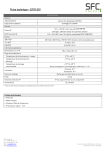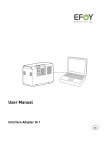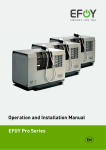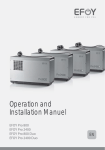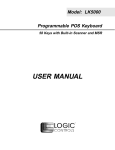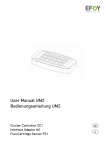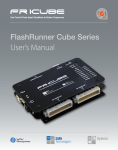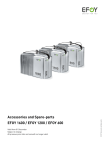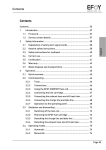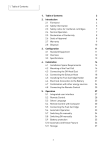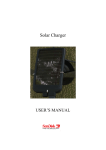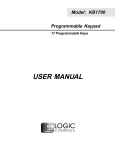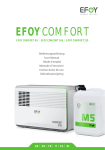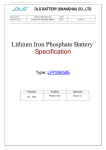Download 1 Introduction
Transcript
User Manual Interface Adapter IA1 / Computer Interface EFOY 600 / EFOY 900 / EFOY 1200 / EFOY 1600 2 1. Introduction 1. Introduction 1.1 Introduction Thank you for choosing an EFOY product. Please read this manual as well as the EFOY Fuel Cell user manual before using the interface adapter. Please note the instructions for installation and the warnings in both manuals. Contact the EFOY hotline should you have any questions about installation or operation. SFC Smart Fuel Cell AG Eugen-Sänger-Ring 4 D-85649 Brunnthal-Nord Hotline: +49 89 673 5920 Toll-free: 00800 732 762 78* [email protected] www.efoy.com *Toll-free in the following countries: Germany, Austria, Belgium, Denmark, France, Great Britain, Italy, the Netherlands, Norway, Spain, Sweden and Switzerland. 3 1. Introduction 1.2 Safety Precautions Read the user manual beforehand and keep the manual handy at all times. Follow all instructions in the manual. Connect the EFOY fuel cell to a computer using an interface adapter only. Otherwise, damage to the EFOY fuel cell may result. Damage may also result from improper use or improper connection to other electrical devices. In addition to these safety precautions, please note any passages in bold type to avoid creating a hazard to yourself and others. 1.3 Intended Use You can connect a computer to an EFOY fuel cell with an IA1 interface adapter and a data line (Cat.5 patch cable) for the following functions: • • • 1.4 to retrieve information to modify operating parameters to operate the EFOY unit via a computer Conformity Declaration SFC Smart Fuel Cell AG, Eugen-Sänger-Ring 4, 85649 Brunnthal-Nord declares that the IA1 interface adapter conforms to EU guidelines for electromagnetic compatibility (89/336/EWG). The following norms apply: DIN EN 61000-6-1, DIN EN 61000-6-3 4 1. Introduction 1.5 Packaging Disposal Packaging protected your interface adapter during shipping. All materials are environmentally friendly and recyclable. Please help protect our environment by disposing of packaging properly. Your dealer or community authorities can inform you about proper disposal. Risk of suffocation! Keep packaging and parts out of children’s reach. Plastic wrap or cardboard can cause suffocation. Used devices Used devices are valuable! They contain raw materials that can be recycled if disposed of properly. Proper disposal contributes to a cleaner environment. The EFOY hotline can provide information about returning used devices. Hotline: +49 89 673 5920 oder 00800 732 762 78* 5 2. Table of Contents 2. Table of Contents 1. Introduction 1.1 Introduction 1.2 Safety Precautions 1.3 Intended Use 1.4 Conformity Declaration 1.5 Disposal 3 3 4 4 4 5 2. Table of Contents 6 3. Interface Adapter 3.1 Parts Included 3.2 Interface Adapter 3.3 Interface Adapter - Specifications 7 7 7 8 4. Configuring the Data Port 4.1 PC System Requirements 4.2 Connection to the Computer 4.3 Setting Up the Terminal Program 9 9 9 11 5. Data Port Commands 18 5.1 Commands 18 5.2 Commands for Selecting Operating Parameters 20 5.3 Commands for Modifying Preset Operating Parameters23 5.4 Commands for Operating the EFOY Unit 25 6. Additional Information 6.1 Explanation of the Operating Parameters 6.2 Permissible Ranges of Operating Parameters 6.3 Explanation of Measured Values 28 28 30 31 7. Troubleshooting 32 6 3. Interface Adpater 3. Interface Adapter 3.1 Parts Included Parts included: • • • IA1 interface adapter IA1 Interface adapter data line (Cat. 5) user manual data line 3.2 Interface Adapter 1 1 2 RJ45 port to connect either a data line or a Cat. 5 patch cable 9-prong D-Sub 9 (RS232) serial interface to connect to PC 2 7 3. Interface Adpater 3.4 Interface Adapter - Specifications Dimensions (L x W x H): 53 x 33 x 16 mm Operating temperature: -35 to +45° C Serial port: D-Sub 9-pin, female Pin assignment (PC): 2 receive data RxD 3 transmit data TxD 5 ground GND RJ45: RJ45 8-pin port Pin assignment (EFOY): 2 receive data RxD 3 transmit data TxD 4 ground GND 8 4. Configuring the Data Port 4. Configuring the Data Port 4.1 PC System Requirements In order to connect an EFOY fuel cell to a computer with an interface adapter, the computer must meet the following requirements: • Terminal program for transmitting and receiving serial data to a port • D-Sub 9 serial plug, male (RS232) 4.2 Connection to the Computer Improper use or connection to other electrical devices may result in damage. Connect the EFOY fuel cell to a computer only with an interface adapter. Otherwise, damage may result to the EFOY fuel cell. Follow the directions for installation and operation contained in the EFOY fuel cell user manual. 1. The EFOY fuel cell must be in either the On, Off or Automatic mode and connected to a functional battery. 2. Connect the end of the data line to the interface adapter. 3. Connect the adapter to your computer with an RS232 type free serial plug. Use only a Cat. 5 data line. Do not use any other kind of line such as ISDN. 9 4. Configuring the Data Port If you have a serial port, please follow the instructions contained in Point 4. If you do not have an RS232 serial port, please use a USB adapter on RS232. USB adapters are usually installed on the computer. Follow the manufacturer’s installation directions. Then connect the interface adapter to the USB adapter. Use a free USB port to connect the adapter to your computer. 4. Connect the RJ45 plug on the data line to the data interface of your EFOY fuel cell. 5. Check the connection between computer and EFOY fuel cell by selecting the terminal program on your computer. If the prompt SFC> appears after you press the Enter key then the connection to the EFOY fuel cell has been established. If you have not yet set up the terminal program, follow the instructions in Chapter 4.3 Setting Up the Terminal Program. 10 4. Configuring the Data Port 4.3 Setting Up the Terminal Program No additional software is necessary to operate an EFOY fuel cell with a computer. Terminal programs are an application on many operating systems and often come preinstalled. The following illustrations will show you how to configure a terminal program such as Windows HyperTerminal so that you can operate your EFOY. First, start the terminal program - in this illustration, Windows HyperTerminal. Once the program is opened, the following window will appear: Enter a name (like SFC unit 1) into the name field. Confirm with OK. 11 4. Configuring the Data Port The window that allows you to select a port will open automatically. Select under “Connect using” the port to which you have connected the interface adapter, such as COM1. If you are not sure to which port the interface adapter is connected, you can change the setting later. You will find information on the available ports in your computer’s Device Manager. Confirm with “OK“. The window for configuring the port will then appear. 12 4. Configuring the Data Port The following settings are necessary to establish the connection to the EFOY unit: Bits per second: Data bits: Parity: Stop bits: Flow control: 9600 8 none 1 none Use the settings as given above and confirm with “OK“. All settings must be entered correctly. Otherwise, a faulty connection may result or the terminal program will not be able to connect to the EFOY unit. 13 4. Configuring the Data Port After confirming, you should now see a blank terminal screen. You will also need to perform the following settings for the HyperTerminal’s line feed: Open “File” and select “Properties” 14 4. Configuring the Data Port The following window will appear: Select the tab “Settings”; then press the “ASCII Configuration” button. 15 4. Configuring the Data Port The following window will open. Please perform the settings as indicated: Close the window by clicking “OK” and confirm the “Properties” window with “OK”. The terminal is now configured and is ready to operate. You can connect or disconnect using the two telephone symbols in the upper left. The connection is automatically activated after the initial configuration. You can verify this by viewing the status bar at the lower left. 16 4. Configuring the Data Port Connect or disconnect Connection status Test the EFOY connection by pressing the “Enter” key. The EFOY unit will respond with the prompt SFC> If there is no response, the connection is incorrect. Check to see whether the interface adapter is connected to the port (Com) and whether the connection is active. You can modify the settings in the menu “File\Properties” only after you close the connection. If you change the port, you must reconfigure the settings as described above. You can open the appropriate menu by clicking the “Configure” button. 17 5. Data Port Commands 5. Data Port Commands 5.1 Commands You can view the operating status, modify operating parameters or set up external control via the terminal interface. There are various commands in the terminal interface. They are divided into three categories: • commands for selecting operating parameters (see Chapter 5.2) • commands for modifying preset operating parameters (see Chapter 5.3) • commands for operating the EFOY unit (see Chapter 5.4) The various chapters describe the function of all commands. The following is intended to provide a synopsis of the commands. Enter commands only in upper case, i.e. SFC, and make sure that you have spelled them correctly. Commands for selecting operating parameters Command Brief description Chapter ? Displays all available commands. 5.2 LIMITS Displays the permissible range for every operating parameter. 5.2 SFC Displays the current operating status. 5.2 STDVALUE Displays the default settings for operating parameters set by the command DEFAULT. 5.2 VALUE Displays the current settings for the operating parameters. Use CONFIG to modify them. 5.2 VER The firmware version installed on the EFOY unit. 5.2 18 5. Data Port Commands Commands for modifying preset operating parameters Commands Brief description Chapter CONFIG Permits modification of operating parameters such as forward transient voltage. 5.3 DEFAULT Returns all operating parameters to the default settings. 5.3 Commands for operating the EFOY unit Commands Brief description Chapter BUTTON Replaces pressing the On/Off and the Auto buttons on the remote control. 5.4 LANGUAGE Verifies and modifies the language selection on the remote control. 5.4 LOCKED Locks the software, thus preventing remote control of the EFOY unit via the Remote-On contact. 5.4 REMOTE This control replaces the function of the Remote-On contact for remote control of the EFOY unit that is contained in the CC1 cluster controller. 5.4 RESET Replaces pressing the Reset button on the remote control. 5.4 19 5. Data Port Commands 5.2 Commands for Selecting Operating Parameters The following commands are purely for information purposes i.e., you can retrieve data without modifying the configuration. Command Output in the terminal program ? This command (only a question mark) summons up the available set of commands with brief descriptions. Example: SFC>?↵? Set of commands ? shows the set of commands BUTTON software controlling of device CONFIG setting customized operation parameters DEFAULT setting default operation parameters LANGUAGE setting language for panel LIMITS reading out limits of operation parameters LOCKED locking control contacts REMOTE remote controlling via software interface RESET restarts the device SFC reading out actual operation state STDVALUE reading out default values for operation parameters VALUE reading out actual set of operation parameters VER reading out version of firmware... ... SFC> 20 5. Data Port Commands Command Output in the terminal program LIMITS↵ Displays the permissible range for all operating parameters. You will find information about the parameters in Chapter 6.1 Explanation of Operating Parameters Example: SFC>LIMITS↵ switch on voltage: min 11.0V max 13.0V switch off voltage: min 13.5V max 14.7V switch off current: min 0.5A max 10.0A reaction time: min 1s max 300s maximal output energy: min 50Wh max 3000Wh altitude of site: min 0m max 2000m capacity of battery: min 40Ah max 200Ah SFC> SFC↵ Permits monitoring of the current operating status by displaying the various parameters. The EFOY unit transmits a largely unformatted string with all available parameters and their current value. The parameters are described in Chapter 6.3. Example: SFC>SFC↵ battery voltage: 12.08V output current: 0.0A operating time: 5.8h operating state: error operating mode: auto change cartridge cartridge level below sensor SFC> 21 5. Data Port Commands Command Output in the terminal program STDVALUE↵ Displays the standard default settings of all operating parameters on the terminal interface but does not set them for actual operation. If they are desired, use the DEFAULT command. Example: SFC>STDVALUE↵ switch on voltage: 12.3V switch off voltage: 14.2V switch off current: 2.0A reaction time: 20s maximal output energy: 1200Wh altitude of site: 500m capacity of battery: 50Ah SFC> VALUE↵ Displays the current set of operating parameters without modifying them. Example: SFC>VALUE↵ switch on voltage 12.3V switch off voltage 14.2V switch off current 2.0A reaction time 20s maximal output energy 1200Wh altitude of site: 500m capacity of battery: 50Ah SFC> VER↵ Indicates the firmware version. Example: SFC>VER↵ Firmwareversion A50-1 4.03L12V date 2005-08-31 SFC> 22 5. Data Port Commands 5.3 Commands for Modifying Preset Operating Parameters Improper use or modification of operating parameters may lead to battery damage or compromise the EFOY unit’s charging properties. It is thus advisable to ask the manufacturer about the battery’s charging properties before modifying the operating parameters. Work on any electrical facilities should be performed only by qualified personnel in accordance with applicable codes. Command Output in the terminal program CONFIG↵ Displays all operating parameters one after the other along with their current values and the range of possible settings. The system expects a new value. If none is entered, it is sufficient to send a return (ASCIICode 13) to the EFOY unit. Information about operating parameters appears in Chapter 6.1 Explanation of Operating Parameters Example: SFC>CONFIG↵ switch on voltage (actual 1100mV, min 11000mV, max 13000mV)?↵ switch off voltage (actual 14200mV, min 13500mV, max 14700mV)?↵ switch off current (actual 2000mA, min 500mA, max 10000mA)?↵ reaction time (actual 10s, min 1s, max 300s)?20↵ maximal output energy (actual 1560Wh, min 50Wh, max 3000Wh)?↵ altitude of site (actual 500m, min 0m, max 2000m)?↵ capacity of battery (actual 50Ah, min 40Ah, max 200Ah)?↵ switch on voltage: 12.5V 23 5. Data Port Commands switch off voltage: 14.2V switch off current: 1.5A reaction time: 20s maximal output energy: 1560Wh altitude of site: 500m capacity of battery: 50Ah SFC>SFC In this example, the reaction time was changed from 10 seconds to 20 seconds. All other values remain unchanged. We recommend entering the command “VALUE” after modifying the settings and keeping a printout of the new settings with the EFOY unit. DEFAULT↵ Reverts all operating parameters to the factory settings and displays these values as well. Example: SFC>DEFAULT↵ switch on voltage: 12,3V switch off voltage: 14,2V switch off current: 2,0A reaction time: 10s maximal output energy: 1200Wh (Depends on EFOY model) altitude of site: 500m capacity of battery: 50Ah OK SFC> 24 5. Data Port Commands 5.4 Commands for Operating the EFOY Unit Command Output in the terminal program BUTTON [1/0 / AUTO] This allows you to reproduce the functions governed by buttons on the remote control. You must always indicate a parameter corresponding to the button to be “pushed”. Button Parameter auto AUTO On/Off 1/0 Example: SFC>BUTTON AUTO↵ OK SFC>BUTTON↵ no valid parameter SFC>BUTTON 1/0↵ OK SFC> In this example, the EFOY unit began in the automatic mode. No parameter was indicated with the second command. The response was therefore an error message. The third command switches between the ON (1) and OFF (0) status. In the case at hand, (previous status is AUTO), the EFOY unit switches to OFF. LANGUAGE [? / language] Changes the language on the remote control or displays the language currently selected. If the command is transmitted without parameters, the EFOY unit replies with the language currently selected. If a new language is transmitted as a parameter, it registers as a new language. In order to display all available languages, it is necessary to add the parameter ? to the command. Example: 25 5. Data Port Commands SFC>LANGUAGE↵ english SFC>LANGUAGE deutsch↵ OK SFC>LANGUAGE↵ deutsch SFC>LANGUAGE ?↵ English Deutsch Français Italiano Nederlands SFC> LOCKED [ON / OFF] Prevents control of the EFOY unit by the Remote-On contact and prevents remote control of the EFOY unit during servicing, for example. If the command is entered without parameters, the EFOY unit will indicate the current status of the software lock. If you have set the software lock, a lock symbol appear on the remote control. Example: SFC>LOCKED↵ OFF SFC>LOCKED ON↵ OK SFC>LOCKED↵ ON SFC>LOCKED OFF↵ OK SFC> 26 will 5. Data Port Commands Command Output in the terminal program REMOTE [ON / OFF] This command replaces the Remote-On contact contained in the CC1 cluster controller for external control of the EFOY unit. If the command is used without parameters, it will be possible to check the current status of the “software contact”. If you have imposed a software lock, a lock symbol will appear on the remote control. Example: SFC>REMOTE↵ OFF SFC>REMOTE ON↵ OK SFC>REMOTE↵ ON SFC> RESET↵ This command replaces pressing the Reset button on the operating panel. Example: SFC>RESET↵ Note: This is the only command that provokes no response because it immediately triggers a reset of the EFOY unit. 27 6. Additional Information 6. Additional Information 6.1 Explanation of the Operating Parameters Switch-on parameters Operating Parameter Switch-on voltage Function Note The EFOY unit switches on and charges the battery when a predetermined voltage level is reached. A setting that is too high will cause the EFOY unit to switch on frequently. Switch-off Parameters The EFOY fuel cell switches off fully automatically. Controlling the shut-off are the two operating parameters, battery voltage and charging current. In order for EFOY fuel cells to shut off, the switch-off voltage must be exceeded and the current must be lower than the shut-off point. The factory settings are 14.2 volts and 2 A respectively, meaning that the EFOY fuel cell shuts off as soon as battery voltage exceeds 14.2 volts and charging current is lower than 2 A. Operating parameter Function Note Switch-off voltage Once the battery reaches a predetermined voltage, the EFOY unit will switch off, provided that the “switch-off current” parameter is also met. Please note your battery’s end-of-charge voltage. Follow the manufacturer’s recommendations. Switch-off current The EFOY unit will shut off once current dips below this level. If you wish to use battery voltage as the sole switchoff parameter, set for 10000mA since EFOY fuel cells will always produce a lower value. 28 6. Additional Information Miscellaneous Criteria Reaction time The reaction time must elapse before the EFOY unit reacts. For example, switch-on voltage must remain at 12.3 volts for at least ten seconds before the EFOY unit switches on (factory settings). If you are going to briefly use high voltage appliances, coordinate this value with the times of operation. Energy (maximal output energy) If the switch-off criteria, voltage and current, have not been satisfied, the EFOY unit will shut off after generating the number of watt-hours for which it is set. (Example: 1200 watt-hours for the EFOY 1200. Once the switch-on criterion has been satisfied, the EFOY unit will go back on, which can be immediately afterwards. This switch-off criterion prevents unlimited charge cycles caused by things like defective batteries. Altitude of site No effect on EFOY fuel cells Capacity of battery No effect on EFOY fuel cells 29 6. Additional Information 6.2 Permissible Ranges of Operating Parameters Operating parameter 12 V Factory setting Min. Max. Switch-on voltage 12300 mV 11000 mV 13000 mV Switch-off voltage 14200 mV 13500 mV 14600 mV Switch-off current 2000 mA 500 mA 10000 mA Reaction time 10 seconds 1 second 300 seconds Energy maximum output energy Depends on 50 Wh EFOY model* Actual value 3000 Wh * EFOY 600: 600 Wh; EFOY 900: 900 Wh; EFOY 1200: 1200 Wh; EFOY 1600: 1560 Wh Operating parameter 24 V Factory setting Min. Max. Switch-on voltage 24600mV 22000mV 26000mV Switch-off voltage 28200mV 27000mV 29400mV Switch-off current 2000 mA 500 mA 10000 mA Reaction time 10 seconds 1 second 300 seconds 1560 Wh** 50 Wh 3000 Wh Energy maximum output energy **EFOY 1600 24V: 1560 Wh 30 Actual value 6. Additional Information 6.2 Explanation of Measured Values Use the “SFC” command to retrieve these values. See Chapter 5.2 Commands for Selecting Operating Parameters Measured values Example Explanation Battery voltage 12.08V Voltage measured at the battery Output current 0.0A Charging current measured at the fuel cell Operating time 5.8h Hours the EFOY fuel cell has been in operation Operating state error Operating status of the EFOY fuel cell ok: Everything is in order; no errors. error: There is an error or malfunction. Please follow the instructions in the EFOY Fuel Cell user manual. Operating mode auto Displays current operating mode auto: Automatic On Off Error messages change In addition to indicating the operating mode, cartridge the system also displays other text and error messages. Fuel-cartridge sensor cartridge If a fuel-cartridge sensor is used, this will level indicate whether the level is below or above above the sensor level. sensor cartridge level above sensor or no sensor cartridge level below sensor 31 7. Troubleshooting 7. Troubleshooting Description Solution It is not possible to establish a Connect the EFOY unit to a functional battery. connection between the EFOY fuel Configuration is possible only if power is flowing to the cell and the computer. EFOY unit. Check to see whether the data line and the interface adapters are connected (see 4.2 Connection to the Computer) Check the configurations in terminal program (see Chapter 4.3 Setting Up the Terminal Program. Make sure the interface adapter is connected to the allocated port (such as COM 1). Check whether a connection has been established by the terminal program. If using a USB-RS232 adapter: Make sure you have the correct COM port allocation (it generally isn’t a COM1 port). You can check the port in your PC’s Device Manager. Check whether the USB adapter has been properly installed and the PC recognizes it. Commands are not accepted. Enter commands only in upper case, i.e. SFC, and make sure that you have spelled them correctly (see Chapter 6.2 Permissible Ranges of Operating Parameters). Operating parameters cannot be modified. Make sure that the desired value is within the permissible range (see Chapter 6.2 Permissible Ranges of Operating Parameters). _____________________________________________________________________________ _____________________________________________________________________________ _____________________________________________________________________________ _____________________________________________________________________________ _____________________________________________________________________________ _____________________________________________________________________________ _____________________________________________________________________________ _____________________________________________________________________________ _____________________________________________________________________________ _____________________________________________________________________________ _____________________________________________________________________________ _____________________________________________________________________________ _____________________________________________________________________________ _____________________________________________________________________________ _____________________________________________________________________________ _____________________________________________________________________________ _____________________________________________________________________________ _____________________________________________________________________________ _____________________________________________________________________________ _____________________________________________________________________________ _____________________________________________________________________________ _____________________________________________________________________________ _____________________________________________________________________________ _____________________________________________________________________________ _____________________________________________________________________________ _____________________________________________________________________________ _____________________________________________________________________________ _____________________________________________________________________________ _____________________________________________________________________________ _____________________________________________________________________________ _____________________________________________________________________________ _____________________________________________________________________________ _____________________________________________________________________________ _____________________________________________________________________________ _____________________________________________________________________________ _____________________________________________________________________________ _____________________________________________________________________________ _____________________________________________________________________________ _____________________________________________________________________________ _____________________________________________________________________________ _____________________________________________________________________________ _____________________________________________________________________________ Hotline: +49 89 673 5920 Toll-free: 00800 732 762 78* Fax: +49 89 673 592 369 [email protected] www.efoy.com *Toll-free in the following countries: Germany, Austria, Belgium, Denmark, France, Great Britain, Italy, the Netherlands, Norway, Spain, Sweden and Switzerland. 080526_GB_User_Manual_Interface-Adpater_rev02.doc SFC Smart Fuel Cell AG Eugen-Sänger-Ring 4 D-85649 Brunnthal-Nord


































